
Chronology of a long but successful campaign
The mid-eighties
Worldwide the media report increasingly about the export of toxic waste from rich countries after poorer countries. The term "waste export" was coined
Research by Greenpeace: A significant high number of unreported cases of toxic waste exports
1986
Research by Greenpeace: Currently about 163 million tons of garbage are offered worldwide
August 1986
Scene of action: Oceans
14,000 tons of toxic dust (which originate from waste incineration) is on board of the cargo ship "Khian Sea" from Philadelphia / USA. The "Khian Sea" tries to get rid of its load. The Bahamas, the Dominican Republic and other countries already had refused to accept die toxic freight. Greenpeace observes the ship and its freight and informs the authorities just in time. The racketeers of waste tried to unload their toxic freight in vain for 27 months. They can get rid of a part of the cargo in Haiti. The rest of the cargo is, according to the captain of the ship: disposed of "somewhere between Suez and Singapore." Nobody knows till now, where the poison dust has landed, whether on the ocean floor or at any coasts
1987
Greenpeace is launching a campaign against the toxic waste exports. The aim of the campaign: an international export ban!
The non-governmental organization Greenpeace becomes with its investigations an international expert in the issue of toxic waste exports
1987 till 1989
Greenpeace intensively monitored the preliminary negotiations to the Basel Convention: 35 states and the members of the EC agreed control measures and return obligations for hazardous waste shipments. But a general ban is rejected on such exports to countries with lower environmental standards from developed countries. Also the Federal Republic of Germany (Environment Minister Klaus TOEPFER (CDU)) is not interested on such a legislation. Greenpeace, however, still insists on a general export ban. Because of the unsatisfactory outcome of these negotiations the environmental organization decides to organize activities against toxic waste exports
1990
Large amounts of toxic waste are transported from Germany to Poland. Due to the Greenpeace investigations, the Polish government tightened not only her laws about imports but also her border controls
October 1991
Greenpeace has knowledge of more than 1,200 cases of attempted or successful racketeering of toxic waste worldwide
February 1992
Scene of action: Albania
The European Commission calls for the Foreign Office and the German Federal Ministry for the Environment, Nature Conservation and Nuclear Safety (BMU) to be active on the subject of German toxic waste in Albania. Export champion Germany had also disposed a lot of waste in this country
The Green Party of Albania asks the BMU to be active in the matter, too. They also inform Greenpeace International in Amsterdam
October 1991 till June 1992
The Hanoverian company "Schmidt-Cretan GmbH" transported pesticide by rail and truck to Albania. These originate from East German production of the years 1985 to 1987. In reunified Germany, these substances are not allowed
About 480 tons of obsolete pesticides from Germany are identified in Albania. The highly toxic substances Lindan, Trizilin and Falisan are declared as humanitarian aid and should allegedly be used in agriculture. According to Greenpeace, the cost of disposal in Germany are about 4.000-5.000 Euro per ton. The total costs would be approx. 2 million euros in Germany. In comparison, the export costs nothing after Albania
May 1992
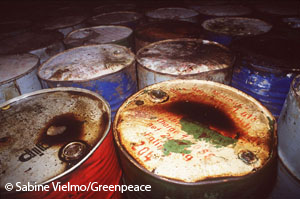
Scene of action: Romania
2,000 tons of pesticides of Germany were identified in Romania, with 465 tons of these in the county of Transylvania alone. Greenpeace discovers the toxic waste under disastrous storage conditions - in barrels, in fragile cardboard boxes and demijohns. A contamination of soil and groundwater is obvious. Under climatic conditions such as heat and cold a disaster is looming.
At the same time the Basel Convention comes into force. However, Germany still opposed the idea of a general ban on toxic waste exports. 88 nations have already signed the agreement.
September 1992
While the German Federal Government remains inactive, Greenpeace becomes active with the subject of a return transport of toxic waste from Romania. The environmental group plans to attract media attention and implements a politically effective action: "A lot of waste and a lot of money" ("Das Muellionending").
The plan includes several levels and operations. A Greenpeace campaigner is conducting the activities: COUNT ANDREAS BERNSTORFF. He has written a fascinating report about the operations: A report from a detective agency - spezialised in the issue of toxic waste
- A courageous Greenpeace researcher performs as an allegedly racketeer of waste. He is to find out about places, where toxic waste is stored in Germany, which is destined for export. How he succeeds can be read in A three-week undercover investigation
- In the next step a truck (loaded with a toxic waste freight) is stopped at the border - under the scrutiny of the media which was previously informed by Greenpeace
- In Romania, the environmentalists become also active
Scene of action: Albania
Radu CRETAN, managing director of the Hanoverian company "Schmidt-Cretan GmbH", operates his business only a few meters further away from his old office, and under a new company name. Although he is regarded as missing at the Hanoverian public prosecutor, he was able to build new halls. And he has secured at least one new contract: 54 tons of obsolete pesticides from GDR production will be transported after Albania.
The Albanian authorities have become aware of the bad condition of the export goods. The authorities have realized that the chemicals are not recyclable and beyond their expiration date.
The chemicals partly are sent back by the Albanian authorities. This toxic waste is disposed of as a hazardous waste on order of the German authorities in Germany.
October 1992
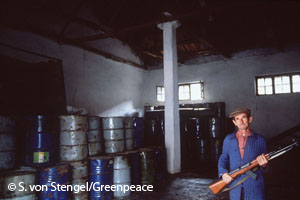
Greenpeace identifies approximately 400 barrels of poison in the port of Durres, in Milot and near Tirana. The public learns for the first time about the German toxic waste by Albanian Government officials. Albanian Government officials follow an invitation of Greenpeace. In the presence of media the Albanian representatives call in Brussels on the Environmental Ministers of the EU to respond appropriately in future and to agree to an export ban
November 1992
Scene of action: Piriapolis (Uruguay)
No progress can be achieved on the first Conference of the Parties of the Basel Convention - after preliminary negotiations took place in 1987-1989
December 1992
Greenpeace accuses the Federal Government to complicate the cooperation between Albania and western environmental organizations in order to cover up toxic waste profiteering
January 1993
Scene of action: Albania
The German Federal Government is now officially prompted by the Albanian Health Minister Tritan SHEHU to take back the toxic waste
February 1st, 1993
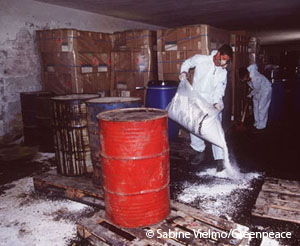
Greenpeace set an ultimatum for Minister TOEPFER. Until February 15th he is to arrange the return of toxins from Romania to Germany. Otherwise Greenpeace threatens, they would transport the toxic waste themselves back. With the support of the population and the government in Romania, Greenpeace activists start a huge cleanup at Romanian toxic waste dumps
February 14th, 1993
German Environment Minister TOEPFER announces to Greenpeace, 450 tons of obsolete pesticides are to be brought back from Romania to Germany in order to recycle the substances
March 11th, 1993
Start of the official "return to sender" - project. Loaded on a 1.3 kilometres long train all findable barrels are transported back to Germany.
August till September 1993
Scene of action: Albania
An expert group of the Federal Biological Research Centre (BBA) - headed by Professor Hans Gerd NOLTING - visits dump locations of toxic waste in Albania. The protocol of the vist become known publicly only by the help of Member of Parliament REUSCHENBERG (SPD) and Greenpeace. The 40-page report makes clear; an acute risk to human health and the environment exists. A disposal or recycling is possible in Germany, because of the undisputed German know-how
November 1993
According to information from the Federal Ministry of the Environment, Nature Conservation and Nuclear Safety (BMU) 217 tonnes of pesticides are at the Albanian border with Montenegro. Because the risk seems acute here, Minister TOEPFER will make available for the necessary security measures 700,000 Euro
January till February 1994
Contrary to the announcement the poison barrels are not secured. Another group of experts of the Agency for Technical Relief (THW), which consists of leaders of the chemical industry, played down the dangers. They claim that there is allegedly no immediate risk to health and the environment. The toxic waste dumps were filmed by Greenpeace.
The emergency aid of 700,000 Euro is withdrawn. Allegedly the EU would take care of the disposal.
Greenpeace discovers that reports of experts were not submitted to the Albanian Government
February 1994
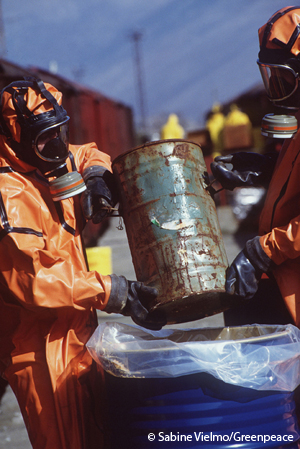
A dump with hazardous substances in the village of Milot / Albania: About 90 tons of obsolete pesticides in a warehouse for grain. The highly toxic pesticide Melipax poured out upon the village street. Skin rashes and breathing problems of the villagers can be identified by Greenpeace. Activists repack the leaking barrels in bigger barrels
March 10th 1994
Scene of action: Albania
A Greenpeace truck is loaded with nearly one ton of toxic waste (origin: Germany). The truck is on the way from Albania via Italy and France to Germany. The vehicle is stopped at the German border. Reason: Illegal import of hazardous waste
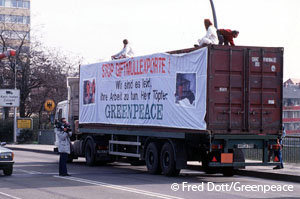
Scene of action: France
Protests on the Europe Bridge, Kehl-Strasbourg!
The truck, loaded with highly toxic pesticides from Albania, is guided by Hans-Peter LOOS. He arrives at the Europe Bridge between Strasbourg and Kehl in the morning. Greenpeace gets problems with the German border authorities. But the activists are stubborn. Initially, the German authorities refuse to authorize the "return to sender" - project. As a result, Greenpeace organizes a 10-hour- strike action on the bridge
Scene of action: Bonn
Minister TOEPFER proclaimed this evening at the Parliament to withdraw all German pesticides from Albania. With the justification to do so because of "purely humanitarian reasons," begins the second major "return to sender" - action from Romania, organized by the Federal Government.
A criminal complaint by the German authorities against Greenpeace (because of the action on the bridge) is shelved, as the NGO has acted "in the best interests" of Germany
March 25th 1994
Scene of action: Geneva
A first success is achieved at the second Conference of Parties to the Basel Convention: A pact with Germany, the USA, Japan, Great Britain, Canada, France and Italy, the so-called G77 countries, with China and third world countries. The "return to sender" - operations and the intense lobbying by Greenpeace have paid off: THE BASEL CONVENTION
The new decisions of the Basel Convention are still not in force in Germany. Merely the original setting of the decisions becomes ratified by Germany. Toxic waste exports, disguised as recycling, are still possible
The majority of the world is forced to act now. A general ban on exporting toxic waste from the area of the OECD to non-OECD countries is enforced of January 1st, 1998
November 1994
Scene of action: Germany
The public is aware of the issue. After several Greenpeace activities, the German Federal Ministry of Environment retrieves now 470 tons of toxic waste from Albania
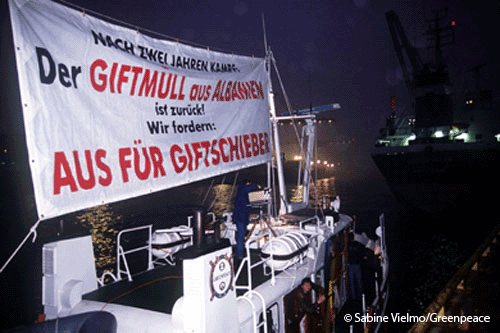
"Louise Green" is the name of a Dutch freighter. The ship brings back a freight of 450 tons of obsolete pesticides to Germany. After the arrival in the port of Hamburg the toxic waste was brought to several incinerators in Hesse and Bavaria. The remains were finally stored underground in Hessian Herfa-Neurode
1995
Bilateral contracts between poor countries and rich nations (such as Germany, Australia and Great Britain) are used to circumvent the Basel Convention
May 1995
Scene of action: India
Another case of toxic waste exports: Grillo Duisburg AG, producer of products in the metallurgy of zinc and sulfur chemical transports 2,400 tons of zinc ash after Bhopal / India
September 19th 1995
Scene of action: Geneva
The third Conference of the Parties decides in Geneva finally and indisputable under international law, the waste export ban of March 1994. Now all participating countries (including Germany) sign THE BASEL CONVENTION
Since 1995
The American Jim PUCKETT observed the activity on the global waste market since 1989. When the toxic waste campaign of Greenpeace was completed in 1995, he carried on. The environmental activist researched, documented, and also prevented global toxic waste trade. He operates his organization BAN - Basel Action Network from the United States. PUCKETT was active during the toxic waste campaign as co-ordinator of Greenpeace campaigner BERNSTORFF and is also head of the toxic waste department at Greenpeace International in Amsterdam
1998
The prohibition decision of 1995 has now become within the European Union an EC Directive on Waste Shipments. Even for recycling purposes toxic waste is no longer allowed to be exported from OECD countries. Violations are punishable by up to ten years in prison
(MH)
Online am: 19.10.2016
Inhalt:
How Greenpeace successfully fought against toxic waste exports
- An overview of the entire project
- Chronology of a long but successful campaign
- 2.000 tons of obsolete pesticides: A trip to Hermannstadt / Sibiu and back
- Count Andreas von Bernstorff - the Greenpeace campaigner
- Frank BRENDEL - Journalist
- A report from a detective agency - specialized in the issue of toxic waste
- A three-week undercover investigation
